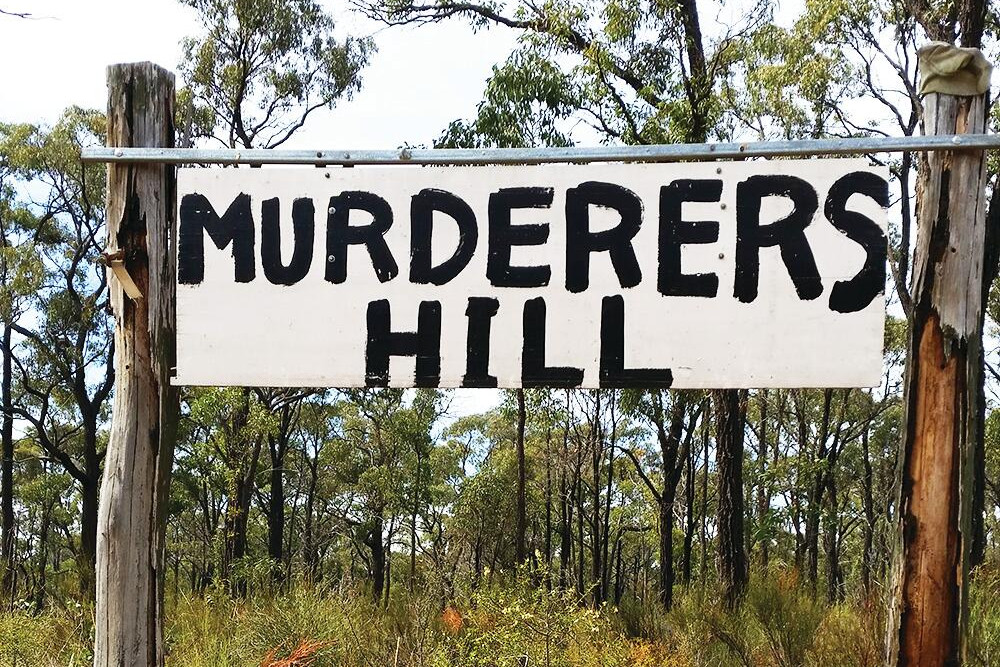General News
8 January, 2025
Summer reading: A tangled web at Murderer's Hill
By KEN ARNOLD ON A gentle rise in the road between Tarnagulla and Dunolly sits a sign noting the place as Murderers Hill. The story of how it came to have that name is as fascinating as it is tangled. Robert Campbell Dunlop, born in June 1823 in...

By KEN ARNOLD
ON A gentle rise in the road between Tarnagulla and Dunolly sits a sign noting the place as Murderers Hill. The story of how it came to have that name is as fascinating as it is tangled.
Robert Campbell Dunlop, born in June 1823 in Scotland, had arrived in the colony of Victoria prior to the gold rush. He married Mary Guthrie in Sydney in 1852, and they had a daughter, Mary Sophia, and possibly another child before they moved to Burnt Creek, now Dunolly.
However, the family was living near Thomson’s store at Long Gully, Jones’s Creek, when Dunlop was murdered around the end of October 1857, aged 35. At that time his wife was pregnant and she was left destitute. She married William Callister around 1879.
Hugh McLean, born Scotland about 1817, was found with a hole in his calico cap matching the hole in his head which had probably been made by a pick when he was also murdered about the same time. Both men were buried at Dunolly.
It seems Dunlop and McLean had found good gold which they took to sell at Chinaman’s Flat, between Timor and Maryborough, in October 1857, so as not to create any suspicion at Jones’s Creek.
At a shop in Dunolly it seems that Job Neil and William Brown noticed they were carrying a lot of money. The two men met up with Richard Dunbeer and his partner Mary Ann Dodd, convincing them to take part in robbing McLean and Dunlop.
Dodd remained by a large tree on the Dunolly to Sandy Creek, now the Tarnagulla road, where she acted as the lookout. As Dunlop struggled with Dunbeer, Neil struck him with a pick prior to McLean being murdered. The bodies were carried to a water hole.
On Sunday November 29, 1857, William Henry Dean saw a partially covered foot protruding from beneath a possum skin rug. Dean returned to Dunolly where he spoke to police officer John McCormack. The area quickly became known as Murderers Hill.
An inquest was told the victims had died by being struck on the back of the head by a sharp object, such as a pick, and they had been in the water hole for some weeks. Although it was thought that one man could not have committed the murders alone Dean was still arrested but was soon released because of insufficient evidence.
He – described as a black man – was again arrested when blood was found on his pick handle, and he spent some weeks in jail before remembering that he had taken the pick into the butcher’s shop in Dunolly.
The story was corroborated by the butcher, and he was again released.
After the offer of a one-hundred-pound reward and free pardon for an accomplice, Samuel Dryden, Robert Jones, John Anderson and Thomas Dearling were arrested in Tarnagulla and taken to Carisbrook charged with the murders. However, the police were unable to produce any real evidence against them and they were soon released, to the cheers of their friends, and much criticism of Her Majesty’s Police Force.
On February 18, 1859, Dunbeer gave himself up and implicated Neil, Brown and Dodd. Dodd also made a statement implicating Neil, however in August 1859 they were charged with perjury as it seems that Dunbeer had implicated Neil as an act of revenge. Dodd, who had been his girl, had left him because of their violent rows saying she was going to her sister in Sydney, but instead had moved in with Neil.
The police believed Dunbeer so they arrested Dodd at Dunolly, but Brown eluded capture. In a backflip, Dunbeer denied he had confessed and implicated the others. There was confusion, the judges were incensed, and much conflicting evidence was presented at trial.
Dodd’s account was very descriptive and put the blame on Neil and Brown, with her statements matching what the police already knew.
Neil denied he was in the area at the time of the murders and said Dodd, whom he called “Polly”, and her sister Mrs Unwin, who was the keeper of a shanty on Sporting Flat, just to the north Dunolly, had admitted that their original evidence was false.
Thomas Unwin went to pieces in the witness box in having to deny his original evidence that supported his wife and “Polly”. By that time Elizabeth Bowen, a sister-in-law to Unwin, was implicated in the trial. During the confused and contradictory evidence, mention was made that the murdered men were ambushed not far from Boan’s shanty, later to become the White Swan hotel at Jones’s Creek.
Unwin, his wife Clara and her sister were all charged with perjury but acquitted in August 1859. Neil was acquitted and released from jail in July 1859. As Dodd was being released from the Castlemaine jail, she unfortunately encountered Dunbeer, who asked permission to speak to her and her two children.
Although handcuffed Dunbeer lurched forward and bit off part of Dodd’s nose. He was charged and was sentenced to three years’ hard labour; his plea of insanity having failed. Nothing further is known about Dunbeer, who died at Tylden in 1903, or Dodd, who died in 1906/7.
The large gum tree under which Mary Ann Dodd sat on the day of the murders was felled in September 1860 to make for the telegraph from Dunolly to Jones’s Creek. Maybe it was revenge for its participation in the horrible deed.